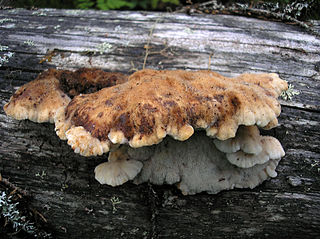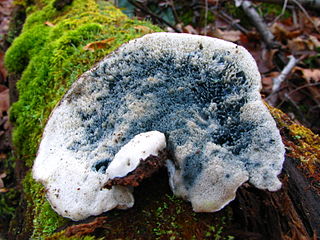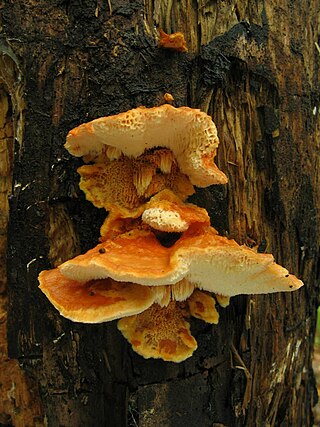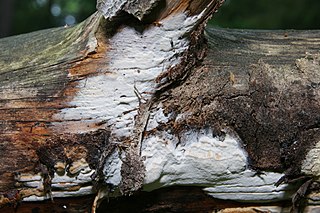Related Research Articles
Edred John Henry Corner FRS was an English mycologist and botanist who occupied the posts of assistant director at the Singapore Botanic Gardens (1929–1946) and Professor of Tropical Botany at the University of Cambridge (1965–1973). Corner was a Fellow of Sidney Sussex College from 1959.

The Polyporaceae are a family of poroid fungi belonging to the Basidiomycota. The flesh of their fruit bodies varies from soft to very tough. Most members of this family have their hymenium in vertical pores on the underside of the caps, but some of them have gills or gill-like structures. Many species are brackets, but others have a definite stipe – for example, Polyporus badius.

Tyromyces chioneus, commonly known as the white cheese polypore, is a species of polypore fungus. A widely distributed fungus, it has a circumpolar distribution, in temperate boreal pine forests, of Asia, Europe, and North America, causes white rot in dead hardwood trees, especially birch.

Oxyporus is a genus of polypore fungi in the family Schizoporaceae. An individual family Oxyporaceae was described for the genus. A number of species in this genus are plant pathogens, causing a white rot. The genus is widely distributed.

Amylocystis is a genus of two species of fungi in the family Fomitopsidaceae. The genus was described in 1944 by mycologists Appollinaris Semenovich Bondartsev and Rolf Singer to contain the type, and at that time, sole species, A. lapponicus. A. unicolor was transferred to the genus in 2003. The generic name Amylocystis is derived from the Ancient Greek words άμυλον ("starch") and χύστιζ ("bladder").

Antrodiella is a genus of fungi in the family Steccherinaceae of the order Polyporales.
Gelatoporia is a fungal genus in the family Gelatoporiaceae. This is a monotypic genus, containing the single widely distributed species Gelatoporia subvermispora. The genus was circumscribed in 1985 by Finnish mycologist Tuomo Niemelä to contain poroid crust fungi with a monomitic hyphal structure, clamped hyphae, and producing white rot.

Datronia is a genus of poroid crust fungi in the family Polyporaceae. The genus was circumscribed by Marinus Anton Donk in 1966, with Datronia mollis as the type species. Datronia fungi cause a white rot in hardwoods. Datronia contains six species found in northern temperate areas. The most recent addition, Datronia ustulatiligna, was described in 2015 from Himachal Pradesh in India.
Laetifomes is a fungal genus in the family Polyporaceae. It is a monotypic genus, containing the single species Laetifomes flammans.

Nigrofomes is a genus of fungi in the family Polyporaceae. It was circumscribed by mycologist William Alphonso Murrill in 1904 with N. melanoporus as the type species. This fungus, first described as Polyporus melanoporus from collections made in Cuba, is common in tropical America. N. nigrivineus, found in Papua New Guinea, was added to the genus in 2013 and N. sinomelanoporus from China was added in 2018.

Oligoporus is a genus of fungi in the family Polyporaceae. The genus was circumscribed by German mycologist Julius Oscar Brefeld in 1888 with Oligoporus farinosus as the type. This species is currently known as Postia rennyi. The genus name combines the Ancient Greek words ὀλίγος ("few") and πόρος ("pore").

Skeletocutis is a genus of about 40 species of poroid fungi in the family Polyporaceae. The genus has a cosmopolitan distribution, although most species are found in the Northern Hemisphere. It causes a white rot in a diverse array of woody substrates, and the fruit bodies grow as a crust on the surface of the decaying wood. Sometimes the edges of the crust are turned outward to form rudimentary bracket-like caps.

Tyromyces is a genus of poroid fungi in the family Polyporaceae. It was circumscribed by mycologist Petter Karsten in 1881. The type species is the widely distributed Tyromyces chioneus, commonly known as the white cheese polypore. The phylogenetic position of Tyromyces within the Polyporales is uncertain, but it appears that it does not belong to the "core polyporoid clade". Tyromyces is polyphyletic as it is currently circumscribed, and has been described as "a dumping place for monomitic white-rot species with thin-walled spores."
Corneroporus is a fungal genus in the family Bankeraceae. It is monotypic, containing the single species Corneroporus subcitrinus, found in Malaysia. This fungus was originally described in the genus Boletopsis by mycologist E. J. H. Corner in 1989.

In Finland, Kotiranta and Niemelä introduced a widely used method for comparing the conservation values of different forest areas, based on the observation that certain wood-rotting fungi are very sensitive to the impact of human activities on forest ecosystems. Such species are slow to return to areas from where they have disappeared, so their presence is evidence of a long continuity in forest ecosystems.

Antrodia pulvinascens is a species of crust fungus in the genus Antrodia that is found in Europe. Czech mycologist Albert Pilát originally described the fungus in 1953 as a species of Poria.
Skeletocutis diluta is a species of poroid crust fungus in the family Polyporaceae. It was first described by Mario Rajchenberg in 1983 as a variety of Skeletocutis nivea. Rajchenberg and Alex David promoted the taxon to independent species status in 1992. The type specimen was collected in Puerto Esperanza, Misiones (Argentina), where it was found growing on Pinus taeda logs in a subtropical forest. It has since been found in Gabon. Skeletocutis diluta has effused-reflexed fruit bodies, meaning they are crust-like with a margin that is extended and bent backwards. It has small allantoid (sausage-shaped) spores measuring 3.1–3.5 by 0.5–0.8 μm. It features a dimitic hyphal system, but the skeletal hyphae dissolve in solution of potassium hydroxide.
Roseofavolus is a monotypic fungal genus in the family Polyporaceae. Circumscribed by Japanese mycologist Tsutomu Hattori in 2003, it contains the single poroid species Roseofavolus eos. This fungus was first described by English mycologist E.J.H. Corner as Grifola eos in 1989. It is found in the Malay Peninsula, Java, and Borneo.
Skeletocutis niveicolor is a species of poroid crust fungus in the family Polyporaceae. It was first described in 1920 by American mycologist William Alphonso Murrill as Poria niveicolor. The type was collected on well-rotted wood found in Cockpit Country, Jamaica in 1909. Leif Ryvarden transferred it to the genus Skeletocutis in 1985. He noted that it was readily distinguished from other Skeletocutis species by its small spores, which measure 2.5–3.1 by 1.5–2 μm. In addition to Jamaica, the fungus has been also reported from Argentina and Costa Rica.
Skeletocutis stramentica is a species of poroid fungus in the family Polyporaceae that is found in New Zealand.
References
- ↑ "GSD Species Synonymy: Skeletocutis falsipileata (Corner) T. Hatt". Species Fungorum. Kew Mycology. Retrieved 2018-04-20.
- ↑ Corner, E.J.H. (1992). "Additional resupinate non-xanthochroic polypores from Brazil and Malesia". Nova Hedwigia. 55: 119–152.
- ↑ Hattori, T. (2002). "Type studies of the polypores described by E.J.H. Corner from Asia and West Pacific Areas. IV. Species described in Tyromyces (1)". Mycoscience. 43 (4): 307–315. doi:10.1007/s102670200045. S2CID 195234251.